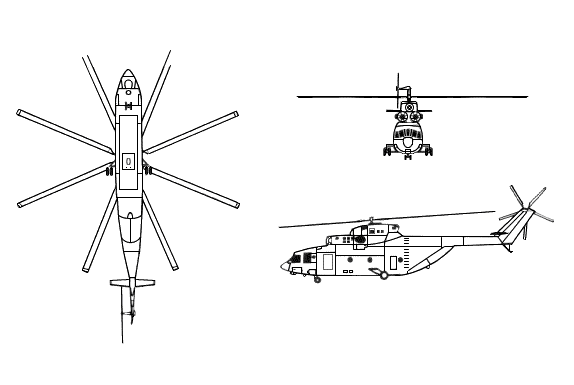




Specifications | |
| Country of Origin | Russia |
| Builder | MIL |
| Date of Introduction | 1983 |
| Role | Heavy cargo-transport |
| Similar Aircraft | Mi-6 Hook, HH-3E Jolly Green Giant |
| Blades | Main rotor - 8 Tail rotor - 5 |
| Rotor diameter | 105 ft (32 m) |
| Length | 111 ft (33.8 m) |
| Length (rotors turning) | 40 meters |
| Length (fuselage) | 33.5 meters |
| Width | 8.2 meters |
| Height | 26 ft., 5 in. / 8.1 meters |
| Tail Rotor Diameter | 7.6 meters |
| Cargo Compartment Dimensions |
12 meters - Floor Length 3.3 meters - Width Height variable from 2.9 to 3.2 meters |
| Weight |
49500 kg - Normal takeoff weight 56000 kg - Maximum takeoff weight 28200 kg - empty weight 20000 kg - Load-lifting capacity (100+ equipped troops, armored vehicles) |
| Engine | 2 x 11,400 shp Lotarev D-136 turbines |
| Maximum speed | 295 km/h |
| Cruising speed | 183 mph / 255 km/h |
| Range |
1200 km with Aux Fuel 800 km with maximum fuel reserve 475-800 km with maximum loading |
| Service Ceiling | 4600 m 1,800 m Hover (out of ground effect) 4,500 m Hover (in ground effect) |
| Fuel | 11,900 liters Internal |
| Standard Payload |
20,000 kg Internal or external load
|
| Armament | Usually none |
| Survivability/Countermeasures |
Main and tail rotor blades electrically deiced. Infrared signature suppressors on engines. Infrared jammers and decoys; flares. Self-sealing fuel tanks. |
| AVIONICS | The avionics and navigational package, a Doppler weather radar, and a fully functioning autopilot allow for day/night all-weather operation. |
| Crew | 5 (2x pilots, 1x navigator, 1x flight engineer, 1x loadmaster) |
| Cost | |
| User Countries | At least 5 countries - India, CIS |
